Comparison of Basic Notch Filters for Semiconductor Optical Amplifier Pattern Effect Mitigation
Abstract
:1. Introduction
2. Basic Optical Notch Filters’ Configurations
3. Optical Notch Filter Requirements for SOA Pattern Effect Suppression
4. ODI vs. MRR Comparison Rationale
5. ODI vs. MRR Comparison: Results and Discussion
6. ODI vs. MRR Qualitative Comparison
- (a)
- FSR:
- (b)
- Detuning:
- (c)
- PNCR:
- (d)
- Temperature sensitivity:
- (e)
- Integration potential:
- (f)
- Multi-wavelength operation:
- (g)
- Tunability:
7. Conclusions
Author Contributions
Conflicts of Interest
References
- Zimmerman, D.R.; Spiekman, L.H. Amplifiers for the masses: EDFA, EDWA, and SOA amplets for metro and access applications. J. Lightwave Technol. 2004, 22, 63–70. [Google Scholar] [CrossRef]
- Bonk, R.; Schmuck, H.; Poehlmann, W.; Pfeiffer, T. Beneficial OLT transmitter and receiver concepts for NG-PON2 using semiconductor optical amplifiers. J. Opt. Commun. Netw. 2015, 7, A467–A473. [Google Scholar] [CrossRef]
- Connelly, M.J. Semiconductor Optical Amplifiers; Kluwer Academic Publishers: Dordrecht, The Netherlands, 2002; Chapter 6. [Google Scholar]
- Mørk, J.; Nielsen, M.L.; Berg, T.W. The dynamics of semiconductor optical amplifiers: Modeling and applications. Opt. Photonics News 2003, 14, 42–48. [Google Scholar] [CrossRef]
- Kamelian. Applications Note No. 0001 “Semiconductor Optical Amplifiers (SOAs) as Power Boosters” and No. 0002 “Semiconductor Optical Amplifiers (SOAs) as Pre-Amplifiers”. Available online: http://www.kamelian.com (accessed on 12 July 2017).
- Spiekman, L.H.; Wiesenfeld, J.; Gnauck, A.; Garrett, L.; Van Den Hoven, G.; Van Dongen, T.; Sander-Jochem, M.; Binsma, J. Transmission of 8 DWDM channels at 20 Gb/s over 160 Km of standard fiber using a cascade of semiconductor optical amplifiers. IEEE Photonics Technol. Lett. 2000, 12, 717–719. [Google Scholar] [CrossRef]
- Udvary, E.; Berceli, T. Semiconductor optical amplifier for detection function in radio over fiber systems. J. Lightwave Technol. 2008, 26, 2563–2570. [Google Scholar] [CrossRef]
- Porto, S.; Antony, C.; Ossieur, P.; Townsend, P.D. An upstream reach-extender for 10 Gb/s PON applications based on an optimized semiconductor amplifier cascade. Opt. Express 2012, 20, 186–191. [Google Scholar] [CrossRef] [PubMed]
- Yiannopoulos, K.; Sagias, N.C.; Boucouvalas, A.C. Fade mitigation based on semiconductor optical amplifiers. J. Lightwave Technol. 2013, 31, 3621–3630. [Google Scholar] [CrossRef]
- Miao, W.; Luo, J.; Di Lucente, S.; Dorren, H.; Calabretta, N. Novel flat datacenter network architecture based on scalable and flow-controlled optical switch system. Opt. Express 2014, 22, 2465–2472. [Google Scholar] [CrossRef]
- Schmuck, H.; Bonk, R.; Poehlmann, W.; Haslach, C.; Kuebart, W.; Karnick, D.; Meyer, J.; Fritzsche, D.; Weis, E.; Becker, J.; et al. Demonstration of an SOA-assisted open metro-access infrastructure for heterogeneous services. Opt. Express 2014, 22, 737–748. [Google Scholar] [CrossRef]
- Pato, S.V.; Meleiro, R.; Fonseca, D.; Andre, P.; Monteiro, P.; Silva, H. All-optical burst-mode power equalizer based on cascaded SOAs for 10-Gb/s EPONs. IEEE Photonics Technol. Lett. 2008, 20, 2078–2080. [Google Scholar] [CrossRef]
- Manning, R.; Ellis, A.; Poustie, A.; Blow, K. Semiconductor laser amplifiers for ultrafast all-optical signal processing. J. Opt. Soc. Am. B 1997, 14, 3204–3216. [Google Scholar] [CrossRef]
- Zoiros, K.; Chasioti, R.; Koukourlis, C.; Houbavlis, T. On the output characteristics of a semiconductor optical amplifier driven by an ultrafast optical time division multiplexing pulse train. Optik 2007, 118, 134–146. [Google Scholar] [CrossRef]
- Rizou, Z.V.; Zoiros, K.E.; Hatziefremidis, A.; Connelly, M.J. Design analysis and performance optimization of a Lyot filter for semiconductor optical amplifier pattern effect suppression. J. Sel. Top. Quantum Electron. 2013, 19, 1–9. [Google Scholar] [CrossRef]
- Bonk, R.; Huber, G.; Vallaitis, T.; Koenig, S.; Schmogrow, R.; Hillerkuss, D.; Brenot, R.; Lelarge, F.; Duan, G.H.; Sygletos, S.; et al. Linear semiconductor optical amplifiers for amplification of advanced modulation formats. Opt. Express 2012, 20, 9657–9672. [Google Scholar] [CrossRef] [PubMed]
- Bogoni, A.; Potì, L.; Ghelfi, P.; Scaffardi, M.; Porzi, C.; Ponzini, F.; Meloni, G.; Berrettini, G.; Malacarne, A.; Prati, G. OTDM-based optical communications networks at 160 Gbit/s and beyond. Opt. Fiber Technol. 2007, 13, 1–12. [Google Scholar] [CrossRef]
- Winzer, P.J.; Essiambre, R.J. Advanced modulation formats for high-capacity optical transport networks. J. Lightwave Technol. 2006, 24, 4711–4728. [Google Scholar] [CrossRef]
- Mecozzi, A.; Mørk, J. Saturation induced by picosecond pulses in semiconductor optical amplifiers. J. Opt. Soc. Am. B 1997, 14, 761–770. [Google Scholar] [CrossRef]
- Inoue, K. Optical filtering technique to suppress waveform distortion induced in a gain-saturated semiconductor optical amplifier. Electron. Lett. 1997, 33, 885–886. [Google Scholar] [CrossRef]
- Watanabe, T.; Yasaka, H.; Sakaida, N.; Koga, M. Waveform shaping of chirp-controlled signal by semiconductor optical amplifier using Mach-Zehnder frequency discriminator. IEEE Photonics Technol. Lett. 1998, 10, 1422–1424. [Google Scholar] [CrossRef]
- Yu, J.; Jeppesen, P. Increasing input power dynamic range of SOA by shifting the transparent wavelength of tunable optical filter. J. Lightwave Technol. 2001, 19, 1316–1325. [Google Scholar] [Green Version]
- Wong, C.; Tsang, H. Reduction of bit-pattern dependent errors from a semiconductor optical amplifier using an optical delay interferometer. Opt. Commun. 2004, 232, 245–249. [Google Scholar] [CrossRef]
- Dong, J.; Zhang, X.; Wang, F.; Hong, W.; Huang, D. Experimental study of SOA-based NRZ-to-PRZ conversion and distortion elimination of amplified NRZ signal using spectral filtering. Opt. Commun. 2008, 281, 5618–5624. [Google Scholar] [CrossRef]
- Hussain, K.; Pradhan, R.; Datta, P. Patterning characteristics and its alleviation in high bit-rate amplification of bulk semiconductor optical amplifier. Opt. Quantum Electron. 2010, 42, 29–43. [Google Scholar] [CrossRef]
- Agrawal, G.P.; Olsson, N.A. Self-phase modulation and spectral broadening of optical pulses in semiconductor laser amplifiers. IEEE J. Quantum Electron. 1989, 25, 2297–2306. [Google Scholar] [CrossRef]
- Wang, J. Pattern Effect Mitigation Techniques for All-Optical Wavelength Converters Based on SOAs. Ph.D. Thesis, Karlsruhe Institute of Technology, Karlsruhe, Germany, 2008. [Google Scholar]
- Zoiros, K.E.; O’Riordan, C.; Connelly, M.J. Semiconductor optical amplifier pattern effect suppression using a birefringent fiber loop. IEEE Photonics Technol. Lett. 2010, 22, 221–223. [Google Scholar] [CrossRef]
- Rizou, Z.; Zoiros, K.; Hatziefremidis, A.; Connelly, M. Performance tolerance analysis of birefringent fiber loop for semiconductor optical amplifier pattern effect suppression. Appl. Phys. B Lasers Opt. 2015, 119, 247–257. [Google Scholar] [CrossRef]
- Zoiros, K.E.; Siarkos, T.; Koukourlis, C.S. Theoretical analysis of pattern effect suppression in semiconductor optical amplifier utilizing optical delay interferometer. Opt. Commun. 2008, 281, 3648–3657. [Google Scholar] [CrossRef]
- Zoiros, K.E.; Rizou, Z.V.; Connelly, M.J. On the compensation of chirp induced from semiconductor optical amplifier on RZ data using optical delay interferometer. Opt. Commun. 2011, 284, 3539–3547. [Google Scholar] [CrossRef]
- Zoiros, K.E.; Janer, C.L.; Connelly, M.J. Semiconductor optical amplifier pattern effect suppression for return-to-zero data using an optical delay interferometer. Opt. Eng. 2010, 49, 1–4. [Google Scholar]
- Rizou, Z.; Zoiros, K.; Hatziefremidis, A. Semiconductor optical amplifier pattern effect suppression with passive single microring resonator-based notch filter. Opt. Commun. 2014, 329, 206–213. [Google Scholar] [CrossRef]
- Katz, O.; Malka, D. Design of novel SOI 1 × 4 optical power splitter using seven horizontally slotted waveguides. Photonics Nanostruct. 2017, 25, 9–13. [Google Scholar] [CrossRef]
- Malka, D.; Peled, A. Power splitting of 1 × 16 in multicore photonic crystal fibers. Appl. Surf. Sci. 2017, 417, 34–39. [Google Scholar] [CrossRef]
- Ben Zaken, B.B.; Zanzury, T.; Malka, D. An 8-channel wavelength MMI demultiplexer in slot waveguide structures. Materials 2016, 9, 881. [Google Scholar] [CrossRef]
- Malka, D.; Sintov, Y.; Zalevsky, Z. Design of a 1 × 4 silicon-alumina wavelength demultiplexer based on multimode interference in slot waveguide structures. J. Opt. 2015, 17, 125702. [Google Scholar] [CrossRef]
- Malka, D.; Sintov, Y.; Zalevsky, Z. Fiber-laser monolithic coherent beam combiner based on multicore photonic crystal fiber. Opt. Eng. 2015, 54, 011007. [Google Scholar] [CrossRef]
- Wong, C.; Tsang, H. Filtering directly modulated laser diode pulses with a Mach-Zehnder optical delay interferometer. Electron. Lett. 2004, 40, 938–940. [Google Scholar] [CrossRef]
- Rabus, D.G. Integrated Ring Resonators: The Compendium; Spring: Berlin, Germany, 2007. [Google Scholar]
- Sumetsky, M. Optimization of resonant optical sensors. Opt. Express 2007, 15, 17449–17457. [Google Scholar] [CrossRef] [PubMed]
- Ruege, A.C. Electro-Optic Ring Resonators in Integrated Optics for Miniature Electric Field Sensors. Ph.D. Thesis, The Ohio State University, Columbus, OH, USA, 2001. [Google Scholar]
- Nielsen, M.L.; Mørk, J. Bandwidth enhancement of SOA-based switches using optical filtering: Theory and experimental verification. Opt. Express 2006, 14, 1260–1265. [Google Scholar] [CrossRef] [PubMed]
- Udvary, E. Off-set filtering effect in SOA based optical access network. Radioengineering 2016, 25, 26–33. [Google Scholar] [CrossRef]
- Yu, H.Y.; Mahgerefteh, D.; Cho, P.S.; Goldhar, J. Optimization of the frequency response of a semiconductor optical amplifier wavelength converter using a fiber Bragg grating. J. Lightwave Technol. 1999, 17, 308–315. [Google Scholar]
- Nielsen, M.L.; Mørk, J.; Suzuki, R.; Sakaguchi, J.; Ueno, Y. Theoretical and experimental study of fundamental differences in the noise suppression of high-speed SOA-based all-optical switches. Opt. Express 2005, 13, 5080–5086. [Google Scholar] [CrossRef] [PubMed]
- Nielsen, M.L. Experimental and Theoretical Investigation of Semiconductor Optical Amplifier (SOA) Based All-Optical Switches. Ph.D. Thesis, Technical University of Denmark, Kongens Lyngby, Denmark, 2004. [Google Scholar]
- Rizou, Z.V.; Zoiros, K.E. Performance analysis and improvement of semiconductor optical amplifier direct modulation with assistance of microring resonator notch filter. Opt. Quantum Electron. 2017, 3, 1–21. [Google Scholar] [CrossRef]
- Vardakas, J.S.; Zoiros, K.E. Performance investigation of all-optical clock recovery circuit based on Fabry-Pérot filter and semiconductor optical amplifier assisted Sagnac switch. Opt. Eng. 2007, 46, 1–21. [Google Scholar]
- Gutiérrez-Castrejón, R.; Filios, A. Pattern-effect reduction using a cross-gain modulated holding beam in semiconductor optical in-line amplifier. J. Lightwave Technol. 2006, 24, 4912–4917. [Google Scholar] [CrossRef]
- Yan, S.; Zhang, Y.; Dong, J.; Zheng, A.; Liao, S.; Zhou, H.; Wu, Z.; Xia, J.; Zhang, X. Operation bandwidth optimization of photonic differentiators. Opt. Express 2015, 23, 18925–18936. [Google Scholar] [CrossRef] [PubMed]
- Agrawal, G.P. Fiber-Optic Communication Systems, 3rd ed.; Wiley: New York, NY, USA, 2002. [Google Scholar]
- Bonk, R.; Vallaitis, T.; Guetlein, J.; Meuer, C.; Schmeckebier, H.; Bimberg, D.; Koos, C.; Freude, W.; Leuthold, J. The input power dynamic range of a semiconductor optical amplifier and its relevance for access network applications. IEEE Photonics J. 2011, 3, 1039–1053. [Google Scholar] [CrossRef]
- Vacondio, F.; Ghazisaeidi, A.; Bononi, A.; Rusch, L.A. Low-complexity compensation of SOA nonlinearity for single-channel PSK and OOK. J. Lightwave Technol. 2010, 28, 277–288. [Google Scholar] [CrossRef]
- Xu, J.; Zhang, X.; Mørk, J. Investigation of patterning effects in ultrafast SOA-based optical switches. IEEE J. Quantum Electron. 2010, 46, 87–94. [Google Scholar] [CrossRef]
- MacWilliams, F.J.; Sloane, N.J. Pseudo-random sequences and arrays. Proc. IEEE 1976, 64, 1715–1729. [Google Scholar] [CrossRef]
- Singh, S.; Kaler, R. Transmission performance of 20 × 10 Gb/s WDM signals using cascaded optimized SOAs with OOK and DPSK modulation formats. Opt. Commun. 2006, 266, 100–110. [Google Scholar] [CrossRef]
- Bhardwaj, A.; Doerr, C.R.; Chandrasekhar, S.; Stulz, L.W. Reduction of nonlinear distortion from a semiconductor optical amplifier using an optical equalizer. IEEE Photonics Technol. Lett. 2004, 16, 921–923. [Google Scholar] [CrossRef]
- Niehusmann, J.; Vörckel, A.; Bolivar, P.H.; Wahlbrink, T.; Henschel, W.; Kurz, H. Ultrahigh-quality-factor silicon-on-insulator microring resonator. Opt. Lett. 2004, 29, 2861–2863. [Google Scholar] [CrossRef] [PubMed]
- Fujiwara, M.; Imai, T.; Taguchi, K.; Suzuki, K.I.; Ishii, H.; Yoshimoto, N. Field trial of 100-km reach symmetric-rate 10 G-EPON system using automatic level controlled burst-mode SOAs. J. Lightwave Technol. 2013, 31, 634–640. [Google Scholar] [CrossRef]
- Porzi, C.; Kado, Y.; Shimizu, S.; Maruta, A.; Wada, N.; Bogoni, A.; Kitayama, K.I. Simple uplink SOA pattern effects compensation for reach-extended 10 G-EPONs. IEEE Photonics. Technol. Lett. 2014, 26, 165–168. [Google Scholar] [CrossRef]
- Kim, H. 10-Gb/s operation of RSOA using a delay interferometer. IEEE Photonics Technol. Lett. 2010, 22, 1379–1381. [Google Scholar] [CrossRef]
- Elrefaie, A.F.; Wagner, R.E.; Atlas, D.; Daut, D. Chromatic dispersion limitations in coherent light wave transmission systems. J. Lightwave Technol. 1988, 6, 704–709. [Google Scholar] [CrossRef]
- Forghieri, F.; Prucnal, P.; Tkach, R.; Chraplyvy, A.R. RZ versus NRZ in nonlinear WDM systems. IEEE Photonics Technol. Lett. 1997, 9, 1035–1037. [Google Scholar] [CrossRef]
- Levaufre, G.; Le Liepvre, A.; Jany, C.; Accard, A.; Kaspar, P.; Brenot, R.; Make, D.; Lelarge, F.; Olivier, S.; Malhouitre, S.; et al. Hybrid III-V/silicon tunable laser directly modulated at 10 Gbit/s for short reach/access networks. In Proceedings of the European Conference on Optical Communication, Cannes, France, 21–25 September 2014. [Google Scholar]
- Dubé-Demers, R.; LaRochelle, S.; Shi, W. Ultrafast pulse-amplitude modulation with a femtojoule silicon photonic modulator. Optica 2016, 3, 622–627. [Google Scholar] [CrossRef]
- Gutiérrez-Castrejón, R.; Occhi, L.; Schares, L.; Guekos, G. Recovery dynamics of cross-modulated beam phase in semiconductor amplifiers and applications to all-optical signal processing. Opt. Commun. 2001, 195, 167–177. [Google Scholar] [CrossRef]
- Gayen, D.K.; Chattopadhyay, T.; Zoiros, K.E. All-optical D flip-flop using single quantum-dot semiconductor optical amplifier assisted Mach-Zehnder interferometer. J. Comput. Electron. 2015, 14, 129–138. [Google Scholar] [CrossRef]
- Zhang, L.; Li, Y.; Song, M.; Beausoleil, R.G.; Willner, A.E. Data quality dependencies in microring-based DPSK transmitter and receiver. Opt. Express 2008, 16, 5739–5745. [Google Scholar] [CrossRef] [PubMed]
- Tazawa, H.; Kuo, Y.H.; Dunayevskiy, I.; Luo, J.; Jen, A.K.Y.; Fetterman, H.R.; Steier, W.H. Ring resonator-based electrooptic polymer traveling-wave modulator. J. Lightwave Technol. 2006, 24, 3514–3519. [Google Scholar] [CrossRef]
- Ye, T.; Cai, X. On power consumption of silicon-microring-based optical modulators. J. Lightwave Technol. 2010, 28, 1615–1623. [Google Scholar]
- Madsen, C.K.; Zhao, J.H. Optical Filter Design and Analysis: A Signal Processing Approach; John Wiley & Sons, Inc.: New York, NY, USA, 1999; pp. 1–5. [Google Scholar]
- Malka, D.; Cohen, M.; Turkiewicz, J.; Zalevsky, Z. Optical micro-multi-racetrack resonator filter based on SOI waveguides. Photonics Nanostruct. 2015, 16, 16–23. [Google Scholar] [CrossRef]
- Wu, Q.; Zhang, H.; Fu, X.; Yao, M. Spectral encoded photonic analog-to-digital converter based on cascaded unbalanced MZMs. IEEE Photonics Technol. Lett. 2009, 21, 224–226. [Google Scholar]
- Bogaerts, W.; De Heyn, P.; Van Vaerenbergh, T.; De Vos, K.; Kumar Selvaraja, S.; Claes, T.; Dumon, P.; Bienstman, P.; Van Thourhout, D.; Baets, R. Silicon microring resonators. Laser Photonics Rev. 2012, 6, 47–73. [Google Scholar] [CrossRef]
- Kim, T.Y.; Hanawa, M.; Kim, S.J.; Hann, S.; Kim, Y.H.; Han, W.T.; Park, C.S. Optical delay interferometer based on phase shifted fiber Bragg grating with optically controllable phase shifter. Opt. Express 2006, 14, 4250–4255. [Google Scholar] [CrossRef] [PubMed]
- Li, J.; Worms, K.; Maestle, R.; Hillerkuss, D.; Freude, W.; Leuthold, J. Free-space optical delay interferometer with tunable delay and phase. Opt. Express 2011, 19, 11654–11666. [Google Scholar] [CrossRef] [PubMed]
- Su, T.; Zhang, M.; Chen, X.; Zhang, Z.; Liu, M.; Liu, L.; Huang, S. Improved 10-Gbps uplink transmission in WDM-PON with RSOA-based colorless ONUs and MZI-based equalizers. Opt. Laser Technol. 2013, 51, 90–97. [Google Scholar] [CrossRef]
- Luo, Z.C.; Cao, W.J.; Luo, A.P.; Xu, W.C. Polarization-independent, multifunctional all-fiber comb filter using variable ratio coupler-based Mach-Zehnder interferometer. J. Lightwave Technol. 2012, 30, 1857–1862. [Google Scholar] [CrossRef]
- Bhardwaj, A.; Sauer, N.; Buhl, L.; Yang, W.; Zhang, L.; Neilson, D.T. An InP-based optical equalizer monolithically integrated with a semiconductor optical amplifier. IEEE Photonics Technol. Lett. 2007, 19, 1514–1516. [Google Scholar] [CrossRef]
- Absil, P.; Hryniewicz, J.; Little, B.; Wilson, R.; Joneckis, L.; Ho, P.T. Compact microring notch filters. IEEE Photonics Technol. Lett. 2000, 12, 398–400. [Google Scholar] [CrossRef]
- Lee, M.C.; Wu, M.C. MEMS-actuated microdisk resonators with variable power coupling ratios. IEEE Photonics Technol. Lett. 2005, 17, 1034–1036. [Google Scholar] [CrossRef]
- Zhou, Z.; Yin, B.; Deng, Q.; Li, X.; Cui, J. Lowering the energy consumption in silicon photonic devices and systems. Photonics Res. 2015, 3, B28–B46. [Google Scholar] [CrossRef]
- Kaspar, P.; Brenot, R.; Le Liepvre, A.; Accard, A.; Make, D.; Levaufre, G.; Girard, N.; Lelarge, F.; Duan, G.H.; Pavarelli, N.; et al. Packaged hybrid III-V/silicon SOA. In Proceedings of the European Conference on Optical Communication, Cannes, France, 21–25 September 2014. [Google Scholar]
- Li, Y.; Zhang, Y.; Zhang, L.; Poon, A.W. Silicon and hybrid silicon photonic devices for intra-datacenter applications: State of the art and perspectives. Photonics Res. 2015, 3, B10–B27. [Google Scholar] [CrossRef]
- Gunn, C. CMOS photonics for high-speed interconnects. IEEE Micro 2006, 26, 58–66. [Google Scholar] [CrossRef]
- Tan, H.N.; Matsuura, M.; Kishi, N. Enhancement of input power dynamic range for multiwavelength amplification and optical signal processing in a semiconductor optical amplifier using holding beam effect. J. Lightwave Technol. 2010, 28, 2593–2602. [Google Scholar] [CrossRef]
- Padmaraju, K.; Bergman, K. Resolving the thermal challenges for silicon microring resonator devices. Nanophotonics 2014, 3, 269–281. [Google Scholar] [CrossRef]
- Ding, Y.; Pu, M.; Liu, L.; Xu, J.; Peucheret, C.; Zhang, X.; Huang, D.; Ou, H. Bandwidth and wavelength-tunable optical bandpass filter based on silicon microring-MZI structure. Opt. Express 2011, 19, 6462–6470. [Google Scholar] [CrossRef] [PubMed]

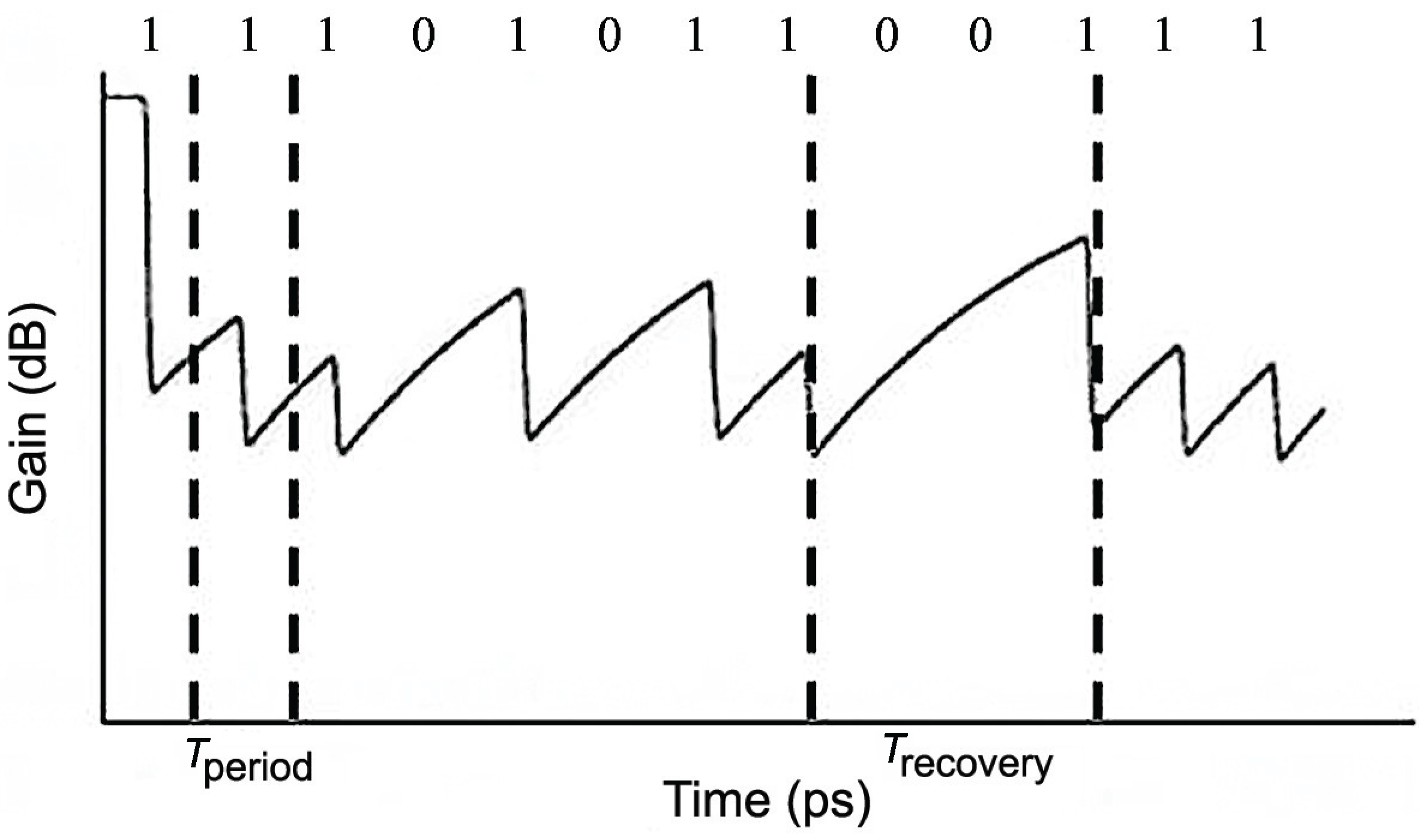


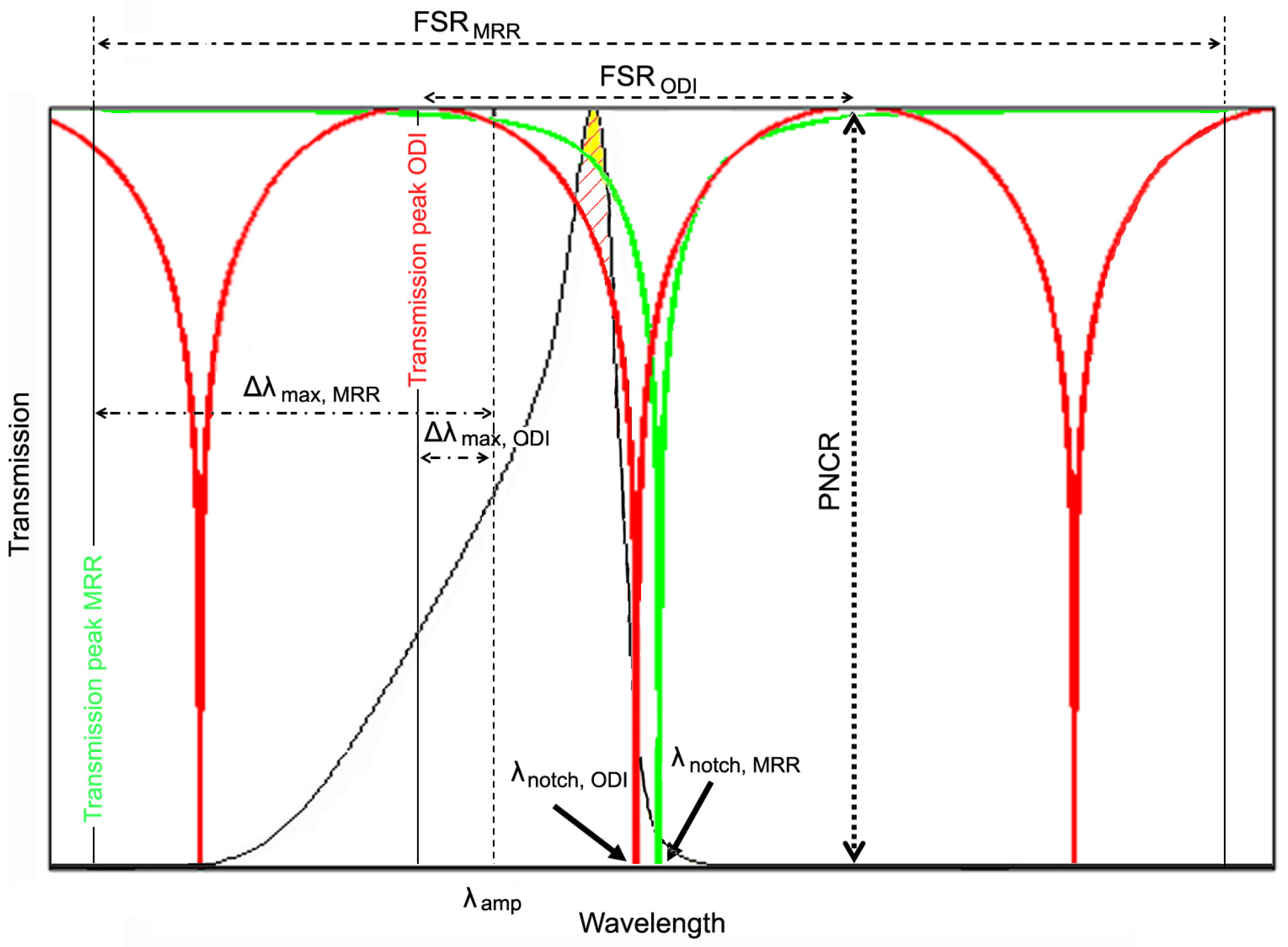
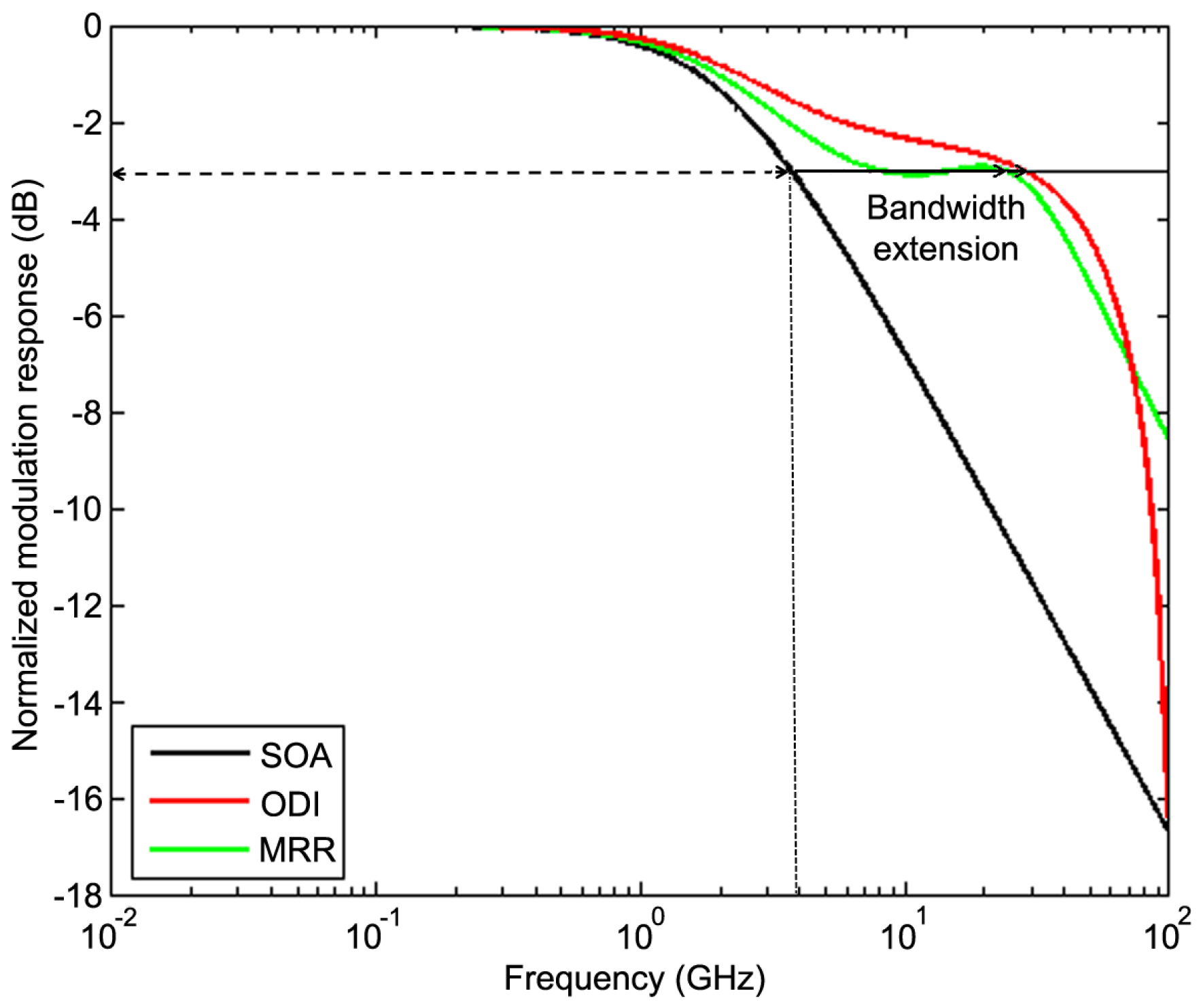


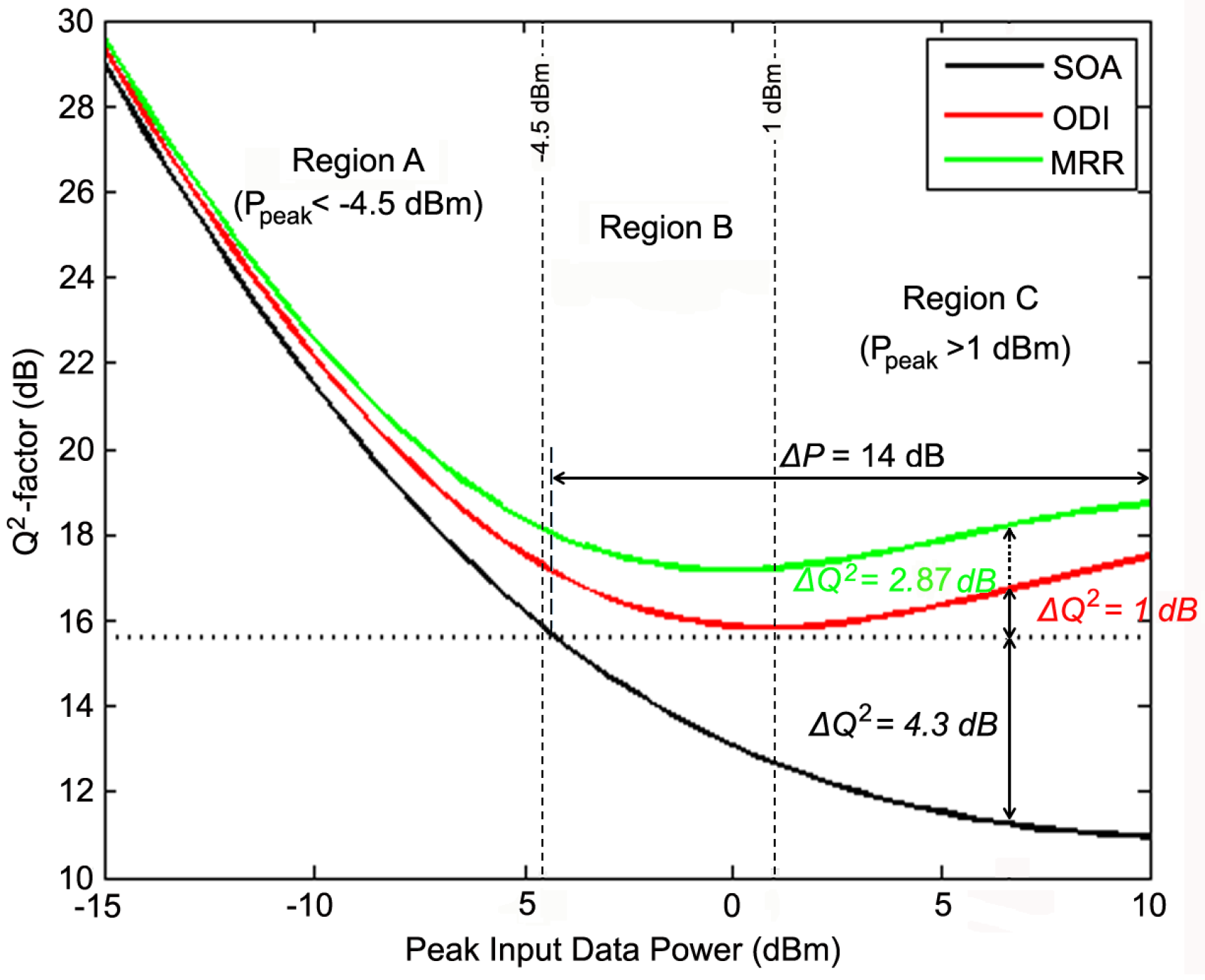
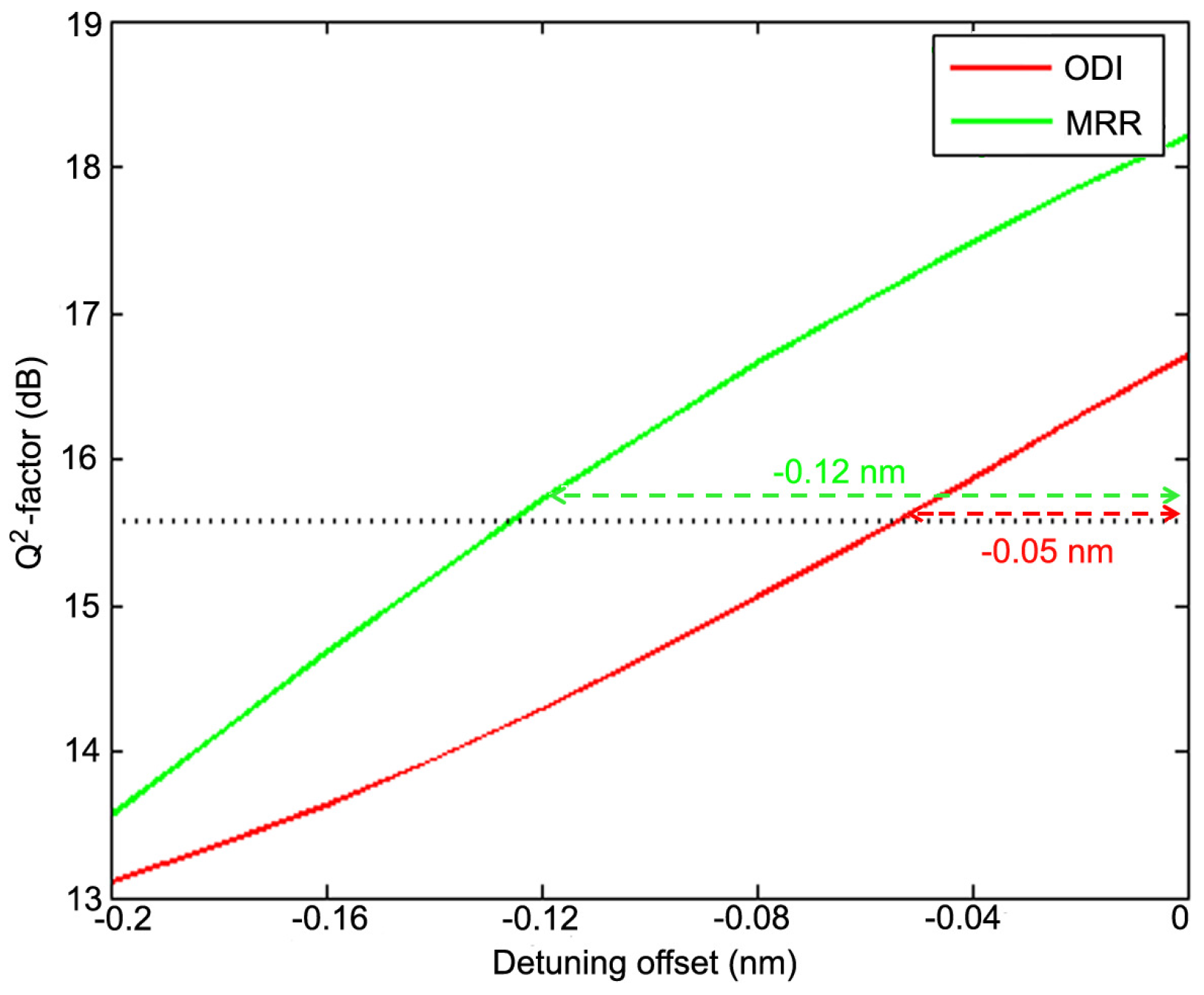

| Parameter | ODI | MRR |
|---|---|---|
| (dB) | 0.22 | 0.34 |
| (dB) | 3 | 2.78 |
| Net gain (dB) | 8.91 * | 12.13 |
| (%) | 93 | 97 |
| (dB) | 14 | 14 |
| (dB) | 1 | 2.87 |
| (negative) Detuning offset (nm) | 0.05 | 0.12 |
| SSMF distance (km) w/o dispersion compensation | 12 | 15 |
| EOP at 12 km (%) | 87 | 91 |
| Characteristic | MRR | ODI | |
|---|---|---|---|
| Free Spectral Range (FSR) | Width | Coarse | Dense |
| Adjustment | Rather fine (radius) | Fine (path length imbalance) or bulky (optical delay line) | |
| Multi-wavelength Operation | Yes | Yes | |
| (i) ITU -Grid | Difficult for DWDM since it requires cascading; is compromised by increased footprint and complexity | Easy for DWDM | |
| (ii) fixed interchannel spacing and spectral width | Yes, easy with single MRR owing to high and controllable finesse | Yes, difficult due to low and fixed finesse | |
| (iii) handling of variations in channel positions | Yes, straightforward owing to sharp spectral selectivity | Yes, requires to concatenate multiple stages at the cost of increased complexity and insertion losses | |
| Detuning | Feasibility | Yes, thermo-optic effect with mWs/FSR | |
| Mechanism | Relaxed (periodic round-trips and resonant enhancement) | Tight (one-way interference) | |
| Precision | Normal | Demanding | |
| Tolerance | High | Medium | |
| Tunability | Yes, high | Yes, medium | |
| Peak-to-Notch Contrast Ratio (PNCR) | Magnitude | High (>20 dB) | |
| Operating Condition | Demanding (critical coupling) | Normal (branching couplers splitting ratio) | |
| Adjustment | Complicated (electrically driving MEMS to control gap between bus and ring) | Simple (varying power splitting ratio) | |
| Tolerance | Tight (matching of field transmission coefficient and amplitude attenuation factor within 3%) | Relaxed (Within 10% of 3-dB power splitting ratio) | |
| Temperature Sensitivity | Yes, high negative TOC material, but still not compatibility with standard CMOS technology | Yes, athermal operation without extra energy consumption | |
| Integration Potential | Compatibility with planar light wave technology | Yes | Yes |
| Co-packaging Platform with SOA | Yes (hybrid) | Yes (monolithic) | |
| Device | Size and footprint | Ultra-compact | Compact or bulk |
| Fabrication, (materials, techniques, processes) | Well-developed | Established | |
| CMOS Compatible | Yes | Yes | |
| Cost | Affordable (single channel amplification in SOA), Shared (multiple channel amplification in SOA) | ||
| Commercial availability | Yes, increasing | Yes, widespread | |
© 2017 by the authors. Licensee MDPI, Basel, Switzerland. This article is an open access article distributed under the terms and conditions of the Creative Commons Attribution (CC BY) license (http://creativecommons.org/licenses/by/4.0/).
Share and Cite
Rizou, Z.V.; Zoiros, K.E.; Hatziefremidis, A. Comparison of Basic Notch Filters for Semiconductor Optical Amplifier Pattern Effect Mitigation. Appl. Sci. 2017, 7, 783. https://doi.org/10.3390/app7080783
Rizou ZV, Zoiros KE, Hatziefremidis A. Comparison of Basic Notch Filters for Semiconductor Optical Amplifier Pattern Effect Mitigation. Applied Sciences. 2017; 7(8):783. https://doi.org/10.3390/app7080783
Chicago/Turabian StyleRizou, Zoe V., Kyriakos E. Zoiros, and Antonios Hatziefremidis. 2017. "Comparison of Basic Notch Filters for Semiconductor Optical Amplifier Pattern Effect Mitigation" Applied Sciences 7, no. 8: 783. https://doi.org/10.3390/app7080783




